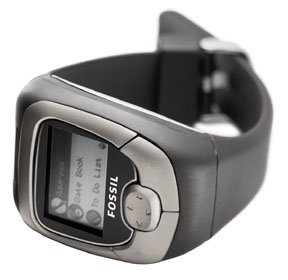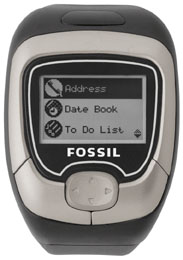Since the day of comic strips and the marvel of Dick Tracy's wrist radio, the public has been fascinated with concepts of watches that will do more than just tell time. There were brief crazes for calculator watches and even data watches that could link to PCs via a cable and flashes on a computer screen. The question was not whether you could merge computing and chronographic concepts, but what features were needed to make a wrist device truly useful.
Now, watch designers at Fossil have embraced the idea of a wrist device that complements PDA devices. Their Wrist PDA and Wrist PDA/PC are designed as companions for Palm Powered and Pocket PC handheld devices. Enabling technologies include the ability to beam information between wrist and handheld devices, a user interface that is consistent with the PDA, and sufficient memory-190KB-to support multiple applications including contact lists, appointments, to do notes, and memos.
At first glance you may treat the Fossil products as curiosities, but these devices are consistent with the long term trend in computing: make it smaller and usable, then add all the features of larger systems. This trend has been apparent since the 1970s with the migration from mainframes to distributed processors, then to desktop computers, to laptops, and currently to PDAs. Along the way, smaller devices have added what were not inherently part of their larger parents. Specifically, multimedia, location-sensitive information, and personal communications are emerging features in today's PDAs.
There's more to the trend than just physical size. Location is also an important factor as we've gone from the raised-floor computer room to a general office, to the desktop, to the briefcase, and currently to the pocket or purse. Wearable devices such as those from Fossil represent the next logical step in this progression.
Fossil has made a good start with its first two products that feature infrared communications between Palm OS and Pocket PCs respectively. Wrist PDAs can now serve as useful data collection devices. Initially, these products can receive and store up to 20 business cards beamed from PDAs. In the future, other types of information such as schedules and location-specific data will be beamed to these wearable devices. One such application could be a schedule of rounds for a doctor or nurse, with appropriate alerts.
The Wrist PDAs also feature built-in configuration software and applications coupled with 190KB of memory. Applications include addresses, date book, memo pad, to do list, and customizable applications. Storage is sufficient for any one of the following: 1,100 contacts, 800 appointments, 5,000 to do's or 350 memos.
The Wrist PDAs are certainly larger than conventional wristwatches, but, at just over 2.5 ounces, their size and weight compare favorably to PDAs. They are also water resistant to 30 meters. That's not a big deal for standard PDA applications, but just think of a future Wrist PDA that may have CCD imaging capability and be useful for underwater photography.
The wrist PDAs are powered by two lithium cells with a projected life of 1.5 to 3 months depending on usage. The 102 x 64 pixel display is adequate for icons and text. A four-direction control on the lower top of the watch facilitates scrolling and selection. Both the Wrist PDA and Wrist PDA/PC will have a suggested retail of US$145 and will be available in early 2002.
These first two products set the stage for what Donald Brewer, Fossil's VP of Technology, calls "wearable wireless." He projects that wearable products with combined PDA and cell phone capabilities will become available later this year. According to Brewer, "Technology elements to create these wearable products exist, the real challenge is to integrate technology and fashion." With wearable devices, he concludes, "suppliers will have to offer a variety of styles compared to just the limited number of models for PDAs and cell phones."
From Fossil's perspective, mobility is about instant access to a set of critical functions with just one hand. The company views a watch configuration as being the premier platform to deliver this capability. They expect the platform to support two streams of development. One stream will support general purpose communications applications and a second will evolve application-specific configurations.

Fossil has made an impressive start in the effort to answer the questions about what functions need to be embodied in a wrist device. But the needed answers won't come just from suppliers. Ultimately it will be users who will demand functionality. As with prior migrations to smaller platforms, we should experience a whole new approach to mobile computing. -
-Neil Kleinman
www.fossil.com
Questions? Comments?
Back to Palm Section



